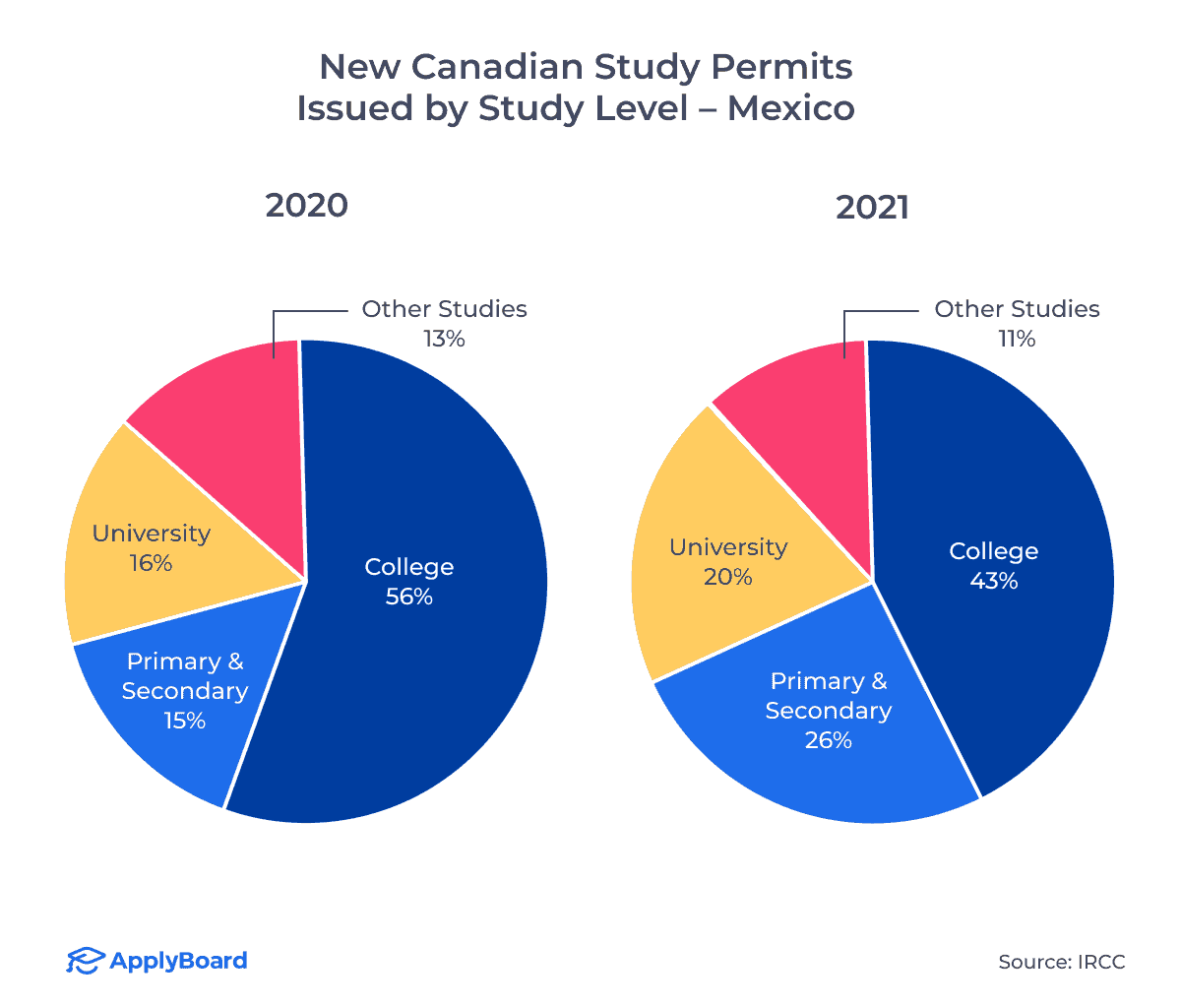Mexico is the largest source of Canadian students from Latin America (LATAM) and continues to be a growing market for Canadian educational institutions. Study permit approvals for Mexican students are recovering from the pandemic quicker than we previously anticipated last year.1
Last month, we looked at Filipino student trends in Canada. In today’s ApplyInsights, we’re turning our attention to Mexico. We’ll look at the increase in student visa2 numbers we’ve seen since borders reopened. We’ll also dig into where in Canada Mexican students are studying and what they’re studying when they get there.
Key Insights at a Glance
- Over 4,000 more Mexican students came to study in Canada in 2021 than in 2020.
- In 2021, 43% of study permits issued to Mexican students were for college studies.
- 1 in 4 study permits issued to Mexican students in 2021 were issued for primary and secondary studies.
- Nearly half of all study permits issued to Mexican students in Canada in 2021 were issued to students studying in British Columbia.
Canadian Student Visa Applications and Approval Rate – Mexico
Mexico has been a key emerging market for Canada. Canada received just over 10,000 study permit applications from Mexican citizens in 2021, a new record. Thanks to a robust approval rate, nearly 8,800 of those students were approved to study in Canada. This was also an all-time high, and represented an increase of 86% from 2019.
This made Mexico the number five source country for international students in Canada in 2021, up from number 11 in 2019. Early 2022 data is also promising.
The table below summarizes the relevant study permit trends:
Mexico has been steadily outperforming other markets, with approval rates increasing six percentage points in 2021 from 2019 rates. In 2021, we saw a jump in study permit applications, representing an increase of 73% from 2019. With mid-year 2022 data, we are expecting these numbers to continue to increase. In just five months of 2022, approval rates for Mexican students are at 87%, which is in line with 2021 levels.
The PGWPP has been a driving factor in the growth in applications from Mexico. From speaking with our recruitment partners in-market, we know that the majority of Mexican students see studying abroad as the first step in their immigration journey. Canada’s generous Post-Graduate Work Permit Program (PGWPP) sets it apart from other English-speaking study abroad destinations, offering students a clear pathway to permanent residency (PR).
The chart below shows how study permit approvals have shifted over the past five years:
Based on historical trends, we estimate there will be over 9,500 study permit approvals in 2022. This would be an all-time high for Mexico, pushing study permit approvals well past 2021 levels.
Canadian Student Visas Issued by Province – Mexico
The map below shows the number of study permits issued to Mexican students in 2021 by province of study, including the change in study permits issued between 2020 and 2021:

British Columbia was the number one destination for Mexican students in Canada by a wide margin, with nearly half of new Mexican students in Canada studying in BC in 2021. In 2021, there were just over 2,700 study permits issued to Mexican students. The growing province had an increase of over 6 times the number of new study permits issued in 2021 compared to 2020.
Ontario was the second most popular destination for Mexican students in Canada in 2021, with just under 1,400 study permits issued. Ontario increased its Mexican student population by 600% in 2021 from last year, which was in line with the total average of all provinces.
Canadian Student Visas Issued by Study Level – Mexico
The charts below show the change in the distribution of study permits issued to Mexican students by study level in 2020 and 2021:

Mexico has always been a college-focused market, and that trend continued into 2021. In 2021, four of the five most popular schools for Mexican students were colleges. The quality, accessibility, and affordability of Canada’s college offerings make Canadian colleges a top target among students looking to obtain PR. Last year, 43% of study permits issued to Mexican students were issued to college students.
In 2021, there was an overall increase of just over 2,600 college students from 2020. This actually represented a 13 percentage point decrease from 2020 to 2021 in the share of Mexican college students. Canadian universities also saw an increase in study permits issued in 2021, with a growth of just over four percentage points from 2020.
Making up the second-largest portion of the Mexican student market, primary and secondary students saw the largest increase in study permits issued in 2021, accounting for nearly 26% of study permits issued in 2021. In 2021, one in four study permits were issued for primary and secondary students. Secondary students made up the majority of this share of Mexican students, accounting for nearly 72% of study permits issued to primary and secondary students.
Local recruitment partners tell us that the increasing popularity of high school study abroad programs among Mexican students is a considerable factor contributing to the number of international students attending Canadian K-12 institutions. Many Mexican families send their secondary students to these programs in order to gain valuable cultural experience outside of Mexico before beginning their undergraduate career.
Key Takeaways
Now the largest source of international students from Latin America to Canada, Mexico is a critical player in the LATAM market. Mexico has been consistently growing in numbers every year since 2016, with nearly double the number of Mexican students who came to study in 2019 coming to Canada in 2021. Canadian schools are seeing increased interest from Mexican students in 2021, with students resuming their study abroad plans.
We expect the number of Mexican students in Canada to continue to increase, with projections showing an all-time high in new study permit approvals for Mexican students. Following pent-up demand from students, Canada’s post-pandemic boom in study permits means good news for Mexican students.
As Canada’s student market shifts, Canadian institutions will be competing to attract students from across the globe. When we look at how Mexico is growing compared to other markets, we are excited to see what the future has in store for Mexican students in Canada!
Schools looking to take advantage of this growth and attract more Mexican students should:
- Solidify industry networks to provide stronger career placements for international students.
- Learn more about the rural immigration pathway pilot programs that are attracting more Mexican students to Atlantic Canada.
- Highlight popular work opportunities and pathways to PR being offered to Mexican students.
Subscribe to ApplyInsights
Sign up for the latest insights on international education.

About the ApplyInsights Team
FOOTNOTES:
1. All data courtesy of Immigration, Refugees and Citizenship Canada (IRCC), except where noted. Statistics used in this article are for new study permits only.
2. The terms student visa and study permit are generally used interchangeably for Canadian international students. Rather than a student visa, Canada provides an approved international student with a study permit, which allows that student to enroll in classes at Canadian institutions. When a student is accepted for a study permit, they are usually also provided with a visitor visa, which allows that student to enter Canada for their studies.



